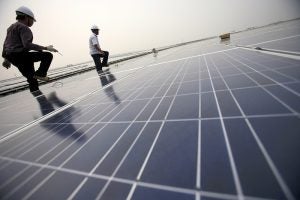With a Record $1.4 Trillion in Sustainability Assets, Investors Bail on Fossil Fuels
 By Namrita Kapur, managing director, Corporate Partnerships
By Namrita Kapur, managing director, Corporate Partnerships
As President-elect Donald Trump puts together his fossil fuel-focused administration, the investment community is moving full speed in the opposite direction, instead putting their bets on emissions reductions and support for clean energy.
Some recent developments:
- Investors controlling more than $5 trillion in assets have committed to dropping some or all fossil fuel stocks from their portfolios, according to a new report tracking the trend.
- Climate change criteria shape the investment of $1.42 trillion in assets under management, a more than fivefold increase since 2014. Clean technology is now a consideration incorporated by money managers with $354 billion in assets under management.
- A recent government bidding process for a large wind farm outside New York State got so many offers the auction had to be extended for a day. The winning bidder was Statoil, an oil company with a growing renewable portfolio willing to pay $42 million, more than twice what the last round of Gulf oil leases generated.
- Microsoft-founder Bill Gates and nearly two dozen other business leaders just launched a new, $1-billion fund that will finance emerging energy innovations to deliver affordable and reliable energy. Breakthrough Energy Ventures’ goal is to reduce global greenhouse gas emissions to near-zero levels.
Why is there so much momentum in the sector now, especially considering the proclivity of the incoming Trump administration for fossil fuels? Because of two short words that mean everything to investors: return and risk.
[Tweet “With a record $1.4 trillion in sustainability assets, investors bail on fossil fuels”]
Price of renewables is right
Although federal policy and the bias of government leaders have an important influence on return and risk, they are far from the only factors. The investment thesis for clean energy is clear.
Prices are dropping, making renewables not only competitive, but ushering in an era of undercutting fossil sources – even without subsidies. Solar energy, for example, is already the lowest-cost option in parts of the world and expected to beat out coal globally by 2025.
Solar energy, for example, is already the lowest-cost option in parts of the world and expected to beat out coal globally by 2025.
In addition, large consumers, looking to insulate themselves from volatility in electricity markets are locking into financially favorable, long-term renewable energy purchases. Corporate power purchasing agreements, or PPAs, had their best year by far in Europe in 2016, totaling more than 1 gigawatt, up from about 400 megawatts in 2015.
Amid coal bankruptcies, investors play it safe
New risks have also cropped up to steer investor behavior.
There is hesitance to fund coal, in particular, as credit ratings have been deteriorating. At least seven coal producers with liabilities of $500 million or more have filed for bankruptcy in the United States since the start of 2014.
Credit downgrades have outnumbered upgrades among coal mining companies this year by about eight to one, Bloomberg data show. Such market realities are immune to politics.
“No turning back”
Besides wanting to address climate change and other risks in their portfolios, investors now seek to reap the rewards of a sector where revenues are outpacing costs and have become a clear value play.
As Pete Grannis, deputy controller at the $185-billion New York State public pension fund, said at an investor side event at the recent international climate talks in Marrakech, “The die has been cast, there is no turning back.”
This post originally appeared on our EDF Voices blog.











One Comment
Time for Washington State to update its net metering legislation to require utilities to pay wholesale prices for customer generation of power when it goes above consumption for the year. As it stands now, any excess power produced in a year is absorbed for free by the utility, which does nothing for improving interest in expanding residential consumer generation of power. There is no incentive to add additional solar panels or a new wind generator if a household is already producing as much as they use, while if they were to get at least the wholesale power rate, it would provide some incentive to expand production and could provide a steady income source for remote areas in the state, especially the sunny and windy eastern half.